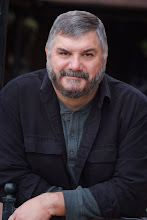Last summer I participated in the two week
Genocide And Human Rights Institute at Northern Illinois University as significant prep for developing VOICES - an ambitious international collaboration that will join theatre artists, media artists, and technologists from Bradley University (Peoria, IL, USA) and the University of Waterloo (Ontario, Canada) with other international collaborators to develop, rehearse, and present an original Internet2/Intermedial theatrical work focused on genocide awareness. The institute was a tremendous learning experience that helped to the solidify the form and scope of the project.
This summer I am focusing on technology by attending the Troika Ranch Live-I Workshop on
Composition for Media and The Stage.Troika Ranch is the collaborative vision of artists Mark Coniglio and Dawn Stoppiello, who will be running the workshop. Established in 1994, and based in New York City and Berlin, Germany, Troika Ranch produces live performances, interactive installations, and digital films, all of which combine traditional aspects of these forms with advanced technologies. The artists’ mission in producing this wide range of art experiences is to create artwork that best reflects and engages contemporary society.
The name Troika Ranch refers to Coniglio and Stoppiello’s creative methodology, which involves a hybrid of three artistic disciplines, dance/theater/media (the Troika), in cooperative interaction (the Ranch)
I know of Troika Ranch through the use of
Isadora, the main technology used to generate the imagery and sound for Troika Ranch’s current projects. Created by Co-Director Mark Coniglio,
Isadora is a graphic programming environment that provides human control over digital media, with special emphasis on real-time manipulation of digital video.
Troika Ranch's Live-I Workshop is an intensive workshop for artists who wish to develop their ability to realize media intensive works for the stage.
The intensive will take place in New York City at the
3LD Art & Technology Center from June 9 - 20, 2009.
Each day, Troika Ranch Artistic Directors Mark Coniglio and Dawn Stoppiello will introduce a new compositional problem revolving around the integration of media and live performance, discuss various strategies and approaches towards the problem, and, send the students off to creatively address that problem through the creation of a short study.
Topics to be covered include:
* Effectively integrating live performers and video imagery on stage
* Using live video/audio feeds to amplify or re-contextualize the performer, and the themes
* Applying notions of film grammar to on-stage imagery
* The use of reactive/interactive systems as an intensifier of liveness
* Considering alternative projection surfaces and/or materials
The trajectory of the exercises is designed so that the outcomes can be woven together into a longer study, which the students will present to the other participants and a small invited public at the workshop's conclusion.
Throughout the workshop, students will be introduced to Isadora® -- the user-friendly, real-time media manipulation tool created by Mark Coniglio. Instead of an exhaustive approach, which might overwhelm those new to such a tool, the focus will be on introducing key features that allow the students to address the compositional problem at hand. In so doing, the students will leave with a basic, solid knowledge of the software that can be put into practice immediately.
Troika Ranch artistic directors Mark Coniglio and Dawn Stoppiello have taught their Live-I Workshop annually in NYC since 1999. The Live-I (Live-Interactive) Workshop is an intensive seminar designed for performance-based artists to explore the use of interactive computer technology in the creation and performance of live artworks. Using technological tools and techniques developed by Troika Ranch over the past 20 years, the participants learn to use their movements and vocalizations to interactively control computer based media, such as sound synthesizers, video playback devices and theatrical lighting in a performance or installation setting.













